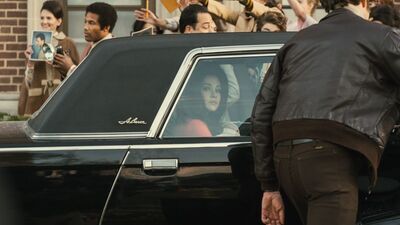An excerpt from a 1993 W Magazine profile of Coppola by Merle Ginsberg reads:
“[Coppola’s] real passions these days are cars, and ‘Hi Octane,’ which was inspired by her thing for automobiles. She stares lovingly at her red ’69 convertible GTO parked just a few feet away. My dad and my brother, Roman, are really into cars, and about a year ago, I got into cars in a serious way. It’s such a boy thing, all these boys have muscle cars, so I had to get my own.”
Interestingly, this pure admiration for the automobile has only begun to come thru in the last decade or so of Coppola’s career as she’s matured. It’s most apparent in her more clear-cut comedies, like 2013’s “The Bling Ring” or 2020’s “On the Rocks.” The former is a true crime story of a group of LA teens who rob a string of celebrity homes to feel close to the fame and excess these figures represent to them. The story is mainly told from the perspective of Marc, an impressionable gay boy who transfers to a new school in Agoura Hills and comes under the thrall of charismatic and unscrupulous Rebecca and her equally vapid clique of friends. For the first time, Coppola represents a city as a playground, as we watch these children play at stardom as they drive around in stolen Bentleys, Jaguars, and Escalades. Notably, Marc is never behind the wheel but always happy to be in the passenger seat or back while the girls drive, perfectly illustrating that he’s primarily going along with the crime spree so he will be accepted. When their complete lack of discretion on social media gets the group caught, the ironic penultimate scene shows Marc get in one last car: a prison bus.
In “On the Rocks,” Laura, a novelist living in Manhattan with her husband Dean and their two daughters, feels stuck in a rut with her creative career as well as her marriage. Dean is constantly on business trips for the tech start-up he founded, which leaves Laura alone to care for their two young daughters and with anxieties that her husband might be having an affair. When she shares her fears with her father Felix, a rich, larger-than life playboy who cheated on Laura’s mother, he only makes her fears worse, insisting that men are biologically incapable of fidelity. In a roundabout maneuver to have quality time with the daughter he neglected, Felix proposes that they investigate Dean together.
Here again, vehicles become toys and a representation of privilege and freedom, but the child here is Felix, who skirts responsibility and lives a life of leisure in semiretirement. Laura uses a Volvo to get her daughters from one place to another with barely any time for her own creative work, which is juxtaposed with Felix, who made his fortune of dealing the art of others, and spends most of his time being chauffeured in a Mercedes Benz by his driver Musto. He swoops in on Laura seemingly whenever he’s bored and lonely, spiriting her away to New York’s most upscale dining institutions to spout regressive views of gender dynamics and flirt with every waitress that he meets. Automotives even figure into how Felix discusses women (this is without a doubt Coppola’s most dialogue-heavy film), saying he hates plastic surgery as he prefers “the factory original,” with Laura retorting, “Yeah and every other make and model.”

